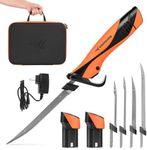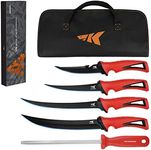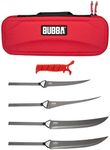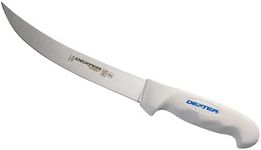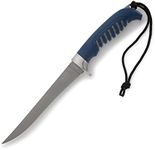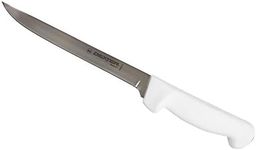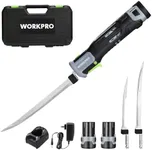Buying Guide for the Best Fishing Knives
Choosing the right fishing knife is essential for any angler, as it can make tasks like cutting lines, cleaning fish, and preparing bait much easier. When selecting a fishing knife, it's important to consider several key specifications to ensure you get a tool that fits your needs and preferences. Here are the main factors to consider when picking a fishing knife.Blade MaterialThe blade material of a fishing knife is crucial because it affects the knife's durability, sharpness, and resistance to corrosion. Common materials include stainless steel, high-carbon steel, and titanium. Stainless steel is popular for its rust resistance and ease of maintenance, making it ideal for use in wet environments. High-carbon steel is known for its sharpness and edge retention but requires more care to prevent rust. Titanium is lightweight, strong, and highly resistant to corrosion, but it can be more expensive. Choose a blade material based on your need for durability, maintenance, and budget.
Blade TypeFishing knives come with different blade types, such as straight, serrated, or a combination of both. A straight blade is excellent for making clean cuts and filleting fish, while a serrated blade is useful for cutting through tough materials like rope or fish scales. Combination blades offer versatility by providing both straight and serrated edges. Consider what tasks you'll be performing most often and choose a blade type that suits those needs.
Blade LengthThe length of the blade can impact the knife's functionality and ease of use. Shorter blades (3-5 inches) offer better control and are ideal for precision tasks like filleting smaller fish. Medium blades (5-7 inches) provide a balance between control and versatility, making them suitable for a variety of tasks. Longer blades (7-9 inches) are better for larger fish and heavy-duty cutting tasks. Think about the size of the fish you typically catch and the tasks you'll be performing to determine the best blade length for you.
Handle MaterialThe handle material of a fishing knife affects comfort, grip, and durability. Common handle materials include rubber, plastic, wood, and composite. Rubber and plastic handles are often textured to provide a secure grip, even when wet. Wood handles offer a traditional look and feel but may require more maintenance. Composite handles combine different materials to offer a balance of comfort, grip, and durability. Choose a handle material that feels comfortable in your hand and provides a secure grip in various conditions.
SheathA sheath is an important accessory for safely storing and carrying your fishing knife. Sheaths can be made from materials like plastic, leather, or nylon. Plastic sheaths are durable and easy to clean, while leather sheaths offer a classic look and feel but may require more maintenance. Nylon sheaths are lightweight and resistant to water. Consider how you'll be carrying your knife and choose a sheath that offers the right balance of protection and convenience.
Additional FeaturesSome fishing knives come with additional features like built-in sharpeners, line cutters, or gut hooks. These features can add convenience and versatility to your knife. Built-in sharpeners allow you to maintain a sharp edge on the go, while line cutters make it easy to quickly cut fishing lines. Gut hooks are useful for field dressing fish. Think about which additional features would be most useful for your fishing activities and choose a knife that includes them.
